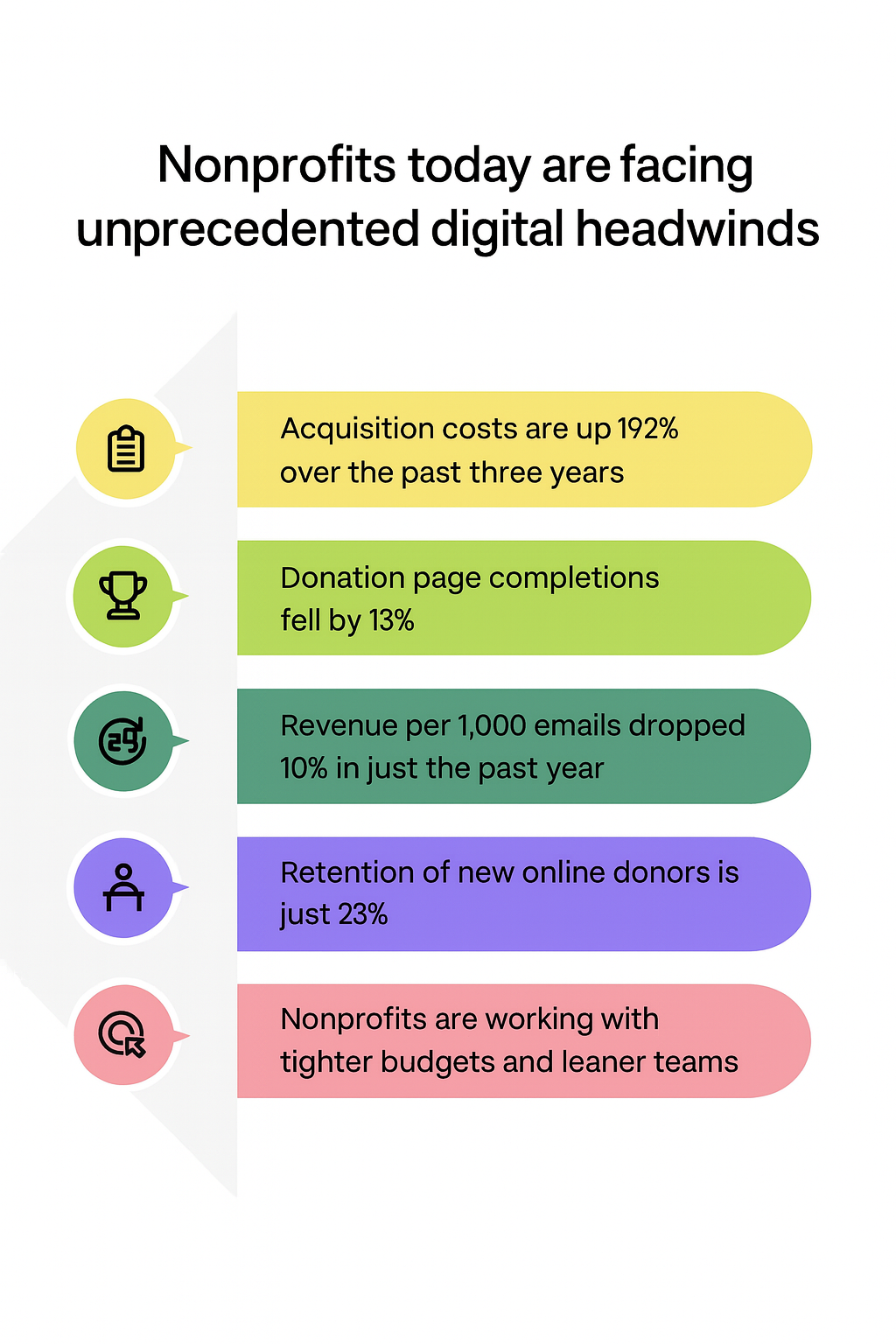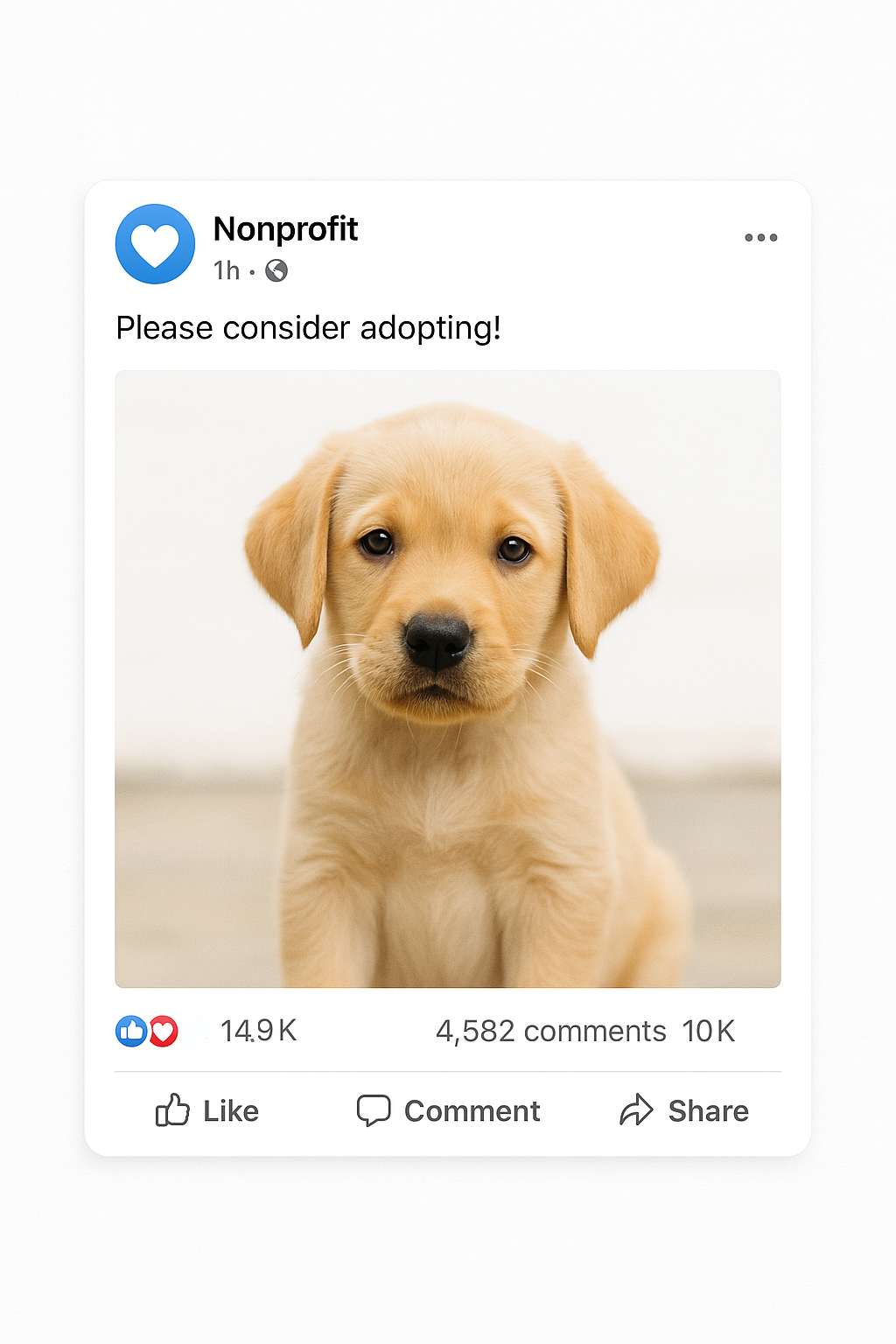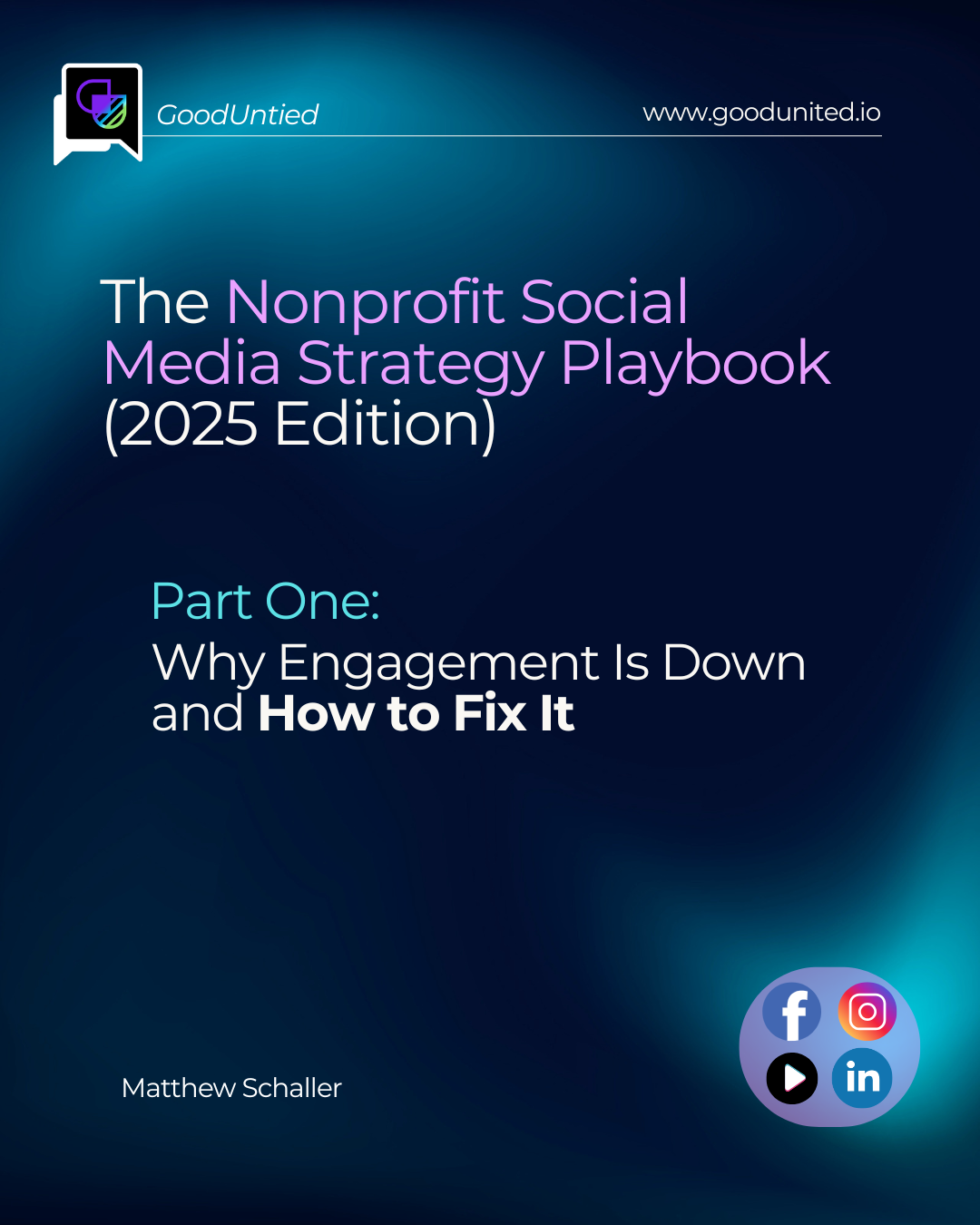
Engagement isn’t a vanity metric—it’s a survival metric.
Nonprofits outperform every other industry in social engagement—
- But 90% still struggle to be seen.
- How does your nonprofit's engagement stack up?
Nonprofits often ask:
“Why is social media engagement so critical now?”
The answer is both technological and existential:
If people don’t interact with your posts, platforms like Facebook, Instagram, and LinkedIn stop showing them to your audience. That’s not theory—it’s algorithmic design.
Social platforms now prioritize what they call “meaningful social interactions.” These include:
- Comments
- Shares
- Saves
- Time spent viewing or replying
But they do not include vanity metrics like passive likes or impressions.
And if your content doesn’t spark those deeper interactions, the platforms assume it’s not relevant. That means:
- Organic reach drops to as little as 2–6%—even among your existing followers
- Future posts get de-prioritized because the algorithm "learns" that your content isn’t engaging
- A compounding effect sets in, making your content harder and harder to surface in feeds
Engagement Isn’t Just About Algorithms—It’s About Staying Viable
Even beyond the algorithm, nonprofits today are facing unprecedented digital headwinds. The latest M+R Benchmarks Report makes it clear:

- Acquisition costs are up 192% over the past three years
- Donation page completions fell by 13%
- Revenue per 1,000 emails dropped 10% in just the past year
- Retention of new online donors is just 23%
- Nonprofits are working with tighter budgets and leaner teams
It’s a perfect storm:
- You're paying more to reach people.
- Fewer of them complete the journey.
- And even when they do, most don’t come back.
So the question isn’t just “Why aren’t we growing?”
It’s “Are we reaching people where they are, in a way that breaks through?”

A Changing Landscape: The 2019–2025 Social Shift
The social media world has transformed dramatically over the past five years, bringing both challenges and new possibilities for nonprofits. Once, a single Facebook post might reach thousands organically. Today, due to algorithm changes—most notably Facebook’s 2018 “friends and family” update—organic reach has plummeted. Page content was de-prioritized, leaving nonprofits scrambling to remain visible.
But this shift did more than change the rules of visibility. It redefined engagement as a form of currency. The algorithms now reward posts that spark conversations, not just attention. Passive likes are insufficient. Platforms like Facebook and Instagram prioritize meaningful social interactions: shares, comments, saves, replies, and extended view time.
For nonprofits, this means one thing: to stay visible, you need content that creates connection and prompts action. That’s not just a tactical adjustment—it’s a full strategic reframe.
Visual Storytelling Is the New Standard
In this algorithm-driven environment, one type of content consistently rises to the top: visual storytelling.
Nonprofits have embraced photos and videos to humanize their mission—and audiences have responded. Short-form video has become a central content format, supercharged by TikTok and Instagram Reels. During the pandemic, live streaming exploded, with nonprofits using Facebook Live and IG Live to offer Q&As, virtual tours, and real-time updates. This trend hasn't faded. Today, audiences expect visual content. They want to see impact, not just read about it.
Whether it’s a candid photo of a rescued pet, a 30-second video of a field team at work, or a behind-the-scenes clip from a community event—visuals drive emotion, and emotion drives engagement.
Shifting Platform Demographics: New Audiences, New Rules
Every platform has evolved:
- TikTok emerged as a major player, especially among Gen Z and younger Millennials. With its algorithmic feed, even small nonprofits can reach massive audiences—if the content resonates.
- Facebook and Instagram have pivoted toward algorithm-recommended content (Reels, suggested creators), pushing nonprofits to focus on content relevance and quality over volume.
- LinkedIn has grown as a hub for nonprofit thought leadership, CSR storytelling, and donor engagement - but still has an algorithm for engagement. Nearly half of nonprofits now maintain active pages.
- Twitter/X, amid its 2022–2023 turbulence, has seen decreased nonprofit use. Still, it remains a place for advocacy campaigns and real-time updates for some.
Despite increased competition, nonprofits have held their ground—and, in many cases, outperformed other industries in engagement benchmarks. The ones that win? They understand the new dynamics and build content that meets audiences where they are.
What the Best Nonprofit Content Has in Common
So, what content actually performs? The answer isn’t gimmicks. It’s a return to something deeply human: stories, emotion, and interaction.
1. Impactful Storytelling (Emotion-Driven Posts)
Emotion drives attention. It also drives action. Posts that center on a specific person, story, or transformation consistently outperform generalized updates.
Example: Seattle Humane shared a post about “Pretty Girl,” a rescued dog. With just a heartfelt image and short story, the post earned a 12.3% engagement rate—dozens of times higher than industry averages.
The Innocence Project used Twitter threads to rally support for an individual on death row. One post using the hashtag #MarcellusWilliams generated 10 million impressions and a 39.7% engagement rate. That’s not luck—it’s narrative power.
Takeaway: Tell real stories of impact. Include photos, quotes, or a short video. Focus on the individual, not the abstract. Make your mission personal.
2. Visual Content (Photos, Carousels & Infographics)
Visuals are essential. On nearly every platform, photo posts earn more engagement than text-only or link posts. Carousels—multi-image posts—are especially powerful on Instagram, with average engagement rates hitting 5.5%.
Infographics also shine, particularly when they educate. UNICEF’s carousel tips for parents or static visual explainers (“3 ways to support refugee children”) are great examples. These posts provide value—and audiences reward that value with saves and shares.
Pro tip: Don’t stress over perfection. Smartphone photos, candid team moments, or quick sketches can outperform glossy graphics if they feel real and human.
3. Short-Form Video (Reels, TikToks, Live Streams)
Video is now the top-performing format across platforms. Short-form video—under 30 seconds—is especially powerful due to its accessibility and algorithmic preference.
Platforms are designed to push Reels and TikToks beyond your follower base. A 15-second testimonial from a program beneficiary can go farther than a lengthy annual report.
Live video remains important too. Going live creates immediacy and connection—audiences love seeing “behind the curtain.”
Guideline: Keep it authentic. Skip the script. A volunteer speaking from the heart, a quick walk-through of an event, or a donor being thanked live often resonate more than polished promos.
4. Interactive Posts and Challenges
What gets rewarded? Engagement. What drives engagement? Conversation.
Polls, quizzes, challenges, and memes perform well not because they’re trendy—but because they invite participation. This is especially true on platforms like Facebook, where the algorithm gives bonus reach to posts that spark dialogue.
Example: “What inspires you to give back during the holidays? 🎁 Comment below!”
These simple asks—when connected to your mission—can generate dozens or hundreds of comments.
Campaigns like #TrashTag or gamified quizzes also drive shares and interaction. They turn social into an active space, not just a broadcast channel.
5. Timely Content and Campaign Hashtags
Every calendar is filled with opportunities. From #GivingTuesday to #PrideMonth to #WorldWaterDay, nonprofits can align their content with moments that matter.
In 2023, GivingTuesday alone saw 34 million participants online and over $3.1B in donations. Nonprofits that planned meaningful content—impact stories, matching gift promotions, thank-you posts—saw elevated engagement across the board.
Tip: Build a content calendar tied to awareness dates. But don’t jump on every trend. Authenticity matters more than trend-chasing.
6. Supporter Recognition and Gratitude Posts
Want shares and goodwill? Shine the spotlight on your community.
Donor thank-you videos, volunteer spotlights, and supporter interviews regularly outperform standard announcements. They also deepen relationships.
Seattle Humane once posted a donor appreciation video featuring dog-themed baked goods—and earned a 12.39% engagement rate, nearly 40× the nonprofit median.
Why it works: Gratitude is magnetic. Recognition shows you value your community, and your community will show up in return.
7. Educational and Expert Content
Don’t just inspire—inform.
Nonprofits are trusted sources on complex issues. By sharing tips, explainers, myth-busting posts, or guides, you can educate while building credibility. These posts work well on LinkedIn, Instagram, and Facebook.
Example: A climate org posts “5 Ways to Cut Carbon at Home.” A health nonprofit shares: “3 Signs of a Stroke to Never Ignore.” These are not just posts—they’re resources.
Format tip: Use carousels, infographics, or short videos to deliver the message visually. Bonus points for content that’s save-worthy or share-worthy.
In Summary: Content That Converts Starts with Connection
As we look ahead in 2025, the nonprofit content that performs best isn’t the most polished. It’s the most personal, emotive, and engaging.
Your audience wants:
- Stories that move them
- Visuals that stop the scroll
- Opportunities to participate
- Recognition for being part of the mission
- Knowledge that informs and empowers
Whether it’s a 20-second TikTok from the field, a carousel on LinkedIn explaining your impact, or a photo of a grateful volunteer—you’re not just posting. You’re building relationships.
Coming Next in the Series
In Part Two, we’ll explore Platform-by-Platform Best Practices—with tactical guidance for content strategy across Facebook, Instagram, LinkedIn, TikTok, and more.
Until then, revisit your most engaging posts. What made them work? How did they connect with your audience?
That’s your roadmap. The strategy isn’t to reinvent the wheel—it’s to build content that feels human, drives interaction, and moves your mission forward.


















